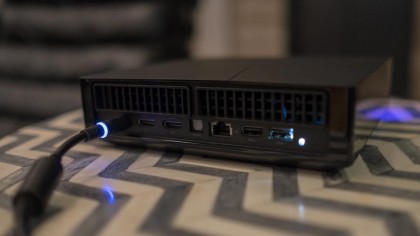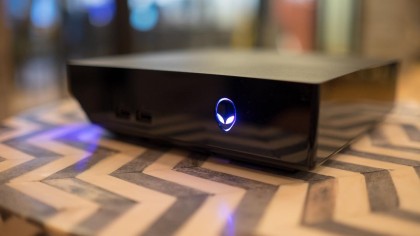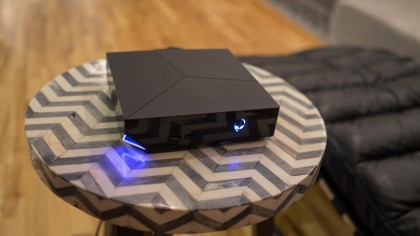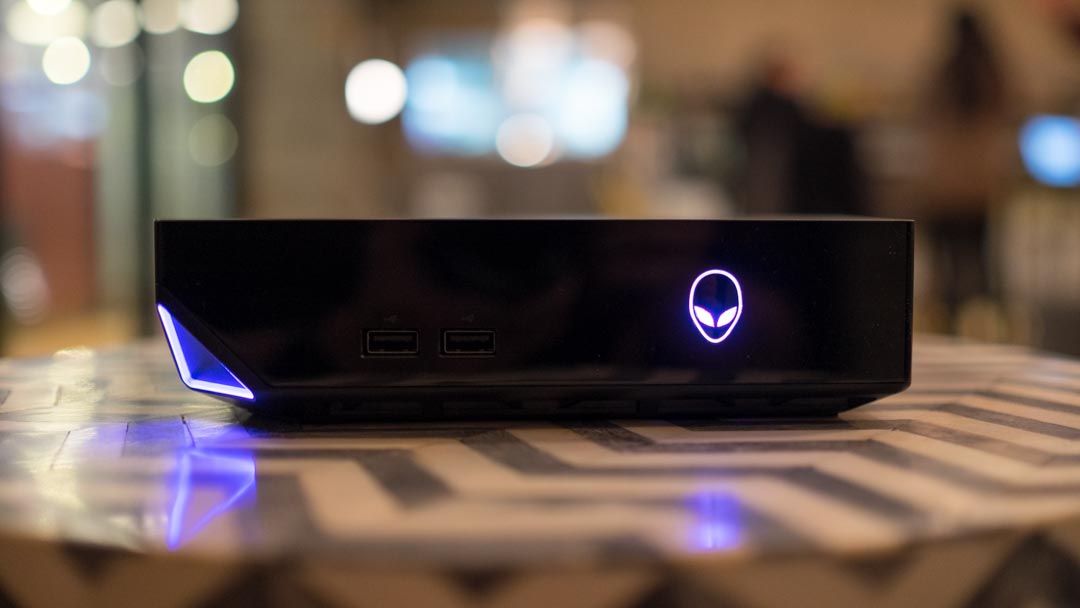TechRadar Verdict
While its custom software is rough around the edges, the Alienware Alpha handily sets the standard for Steam Machines to come with style.
Pros
- +
Stylish, compact design
- +
HDMI in support
- +
Decent performance
- +
Windows-free experience
- +
Upgradeable
Cons
- -
No GPU upgrade
- -
Easily outpriced
- -
No Origin, Uplay support
- -
Rough UI
Why you can trust TechRadar
With or without Valve, the Steam Machines are coming. And with the Alienware Alpha, Dell is one of the first – and arguably the strongest – of the hopeful PC-based game consoles to grace us with its glow … literally.
The final Alienware Alpha, which first debuted during CES 2014, turned out to differ somewhat from the Alienware's vision. Rather than run with SteamOS, Valve's forever-in-beta operating system, Dell packed the Alpha with Windows 8.1. And in lieu of Valve's long-awaited Steam Controller, every Alpha box comes packing an Xbox 360 controller for Windows with a wireless receiver.
Finally, because Alienware beat Valve to the living room, the company had no choice but to develop an intermediary user interface (UI), so that users could play with the Alpha directly out of the box. The result is a product just short of Alienware's grand vision, but nevertheless a stylish, strong and bold device that perhaps is onto something.
But should the Alienware Alpha's $549 (£449, AU$699) price tag scare away the company's target console gamer, PC gamer hopeful audience? A limited-time, US-only $499 starting price (as of this writing) aside, the Alpha has set the bar for Steam Machines to come. However, the "Alpha" moniker will start to seem a tad ironic once we dig deeper into how this machine works.

Design
Since it's big debut at last year's CES, not much has changed about the Alienware Alpha's design language. The diminutive box still sports the same iconic, glowing alien head logo on its face, not to mention the 180-degree slice through its left corner, revealing a triangular LED. This time, however, the illuminated Valve logo is now replaced with a void wrapped in a triangle of light.
Of course, these lights can shine in a variety of colors, chosen through Alienware's custom UI – but more on that later. Just like before, the front of the box allows room for two USB 2.0 ports, with the rest of the inputs and outputs found in the back.
Wrapped in glossy black plastic on its sides and a matte plastic on its top, the Alpha screams style, but also smarts. Three of four of the box's sides feature ventilation for air to either enter or exit, so the machine doesn't get distractingly loud while playing games, nor does it get too hot at all.

I'll be frank: the Alpha is the not only the sharpest-looking Steam Machine yet, it's on par with the Xbox One and PS4 in terms of design. Hell, only a PC could match (or surpass) the leading consoles in power and manage to be a fraction of their size.
Plus, the entire top lid is removable, revealing a host of upgradeable parts. And Alienware encourages you to dive in and upgrade components as you see fit – just don't touch the graphics chip. That's an Nvidia GeForce GTX 860M that's been modified by the Green Team and Alienware to run Nvidia's latest Maxwell chip architecture and at a higher, undisclosed clock speed (higher frequency speed means faster graphics processing), and it is the only component you cannot replace in this machine.
Sure, that's technically an 'interface'
The custom UI that Alienware cooked up in lieu of an official SteamOS release sure gets the job done … but that's about it. Upon booting up the Alpha, you're met with a red screen with a few static, extraterrestrial-like scrawlings on it. Short after, four upright, opaque red rectangles appear with some basic options: Launch Steam, Settings, Help and Power.

Accessible using the controller's direction pad, the option presents the obvious app, in Valve's Big Picture Mode, that started this whole new set of shenanigans. The Settings option offers a number of parameters to tweak from video output settings to available networks and the system's HDMI passthrough capability.
Meanwhile, Help simply shows off all of the controller button combinations to quickly access various nooks and crannies of the UI, and Power lists all of the obvious options in addition to restarting the console in desktop mode (i.e. Windows) – but not without a mouse and keyboard, first.
Functionally speaking, Alienware's UI checks all of the boxes – it provides access to all of the settings that would be relevant to your out-of-the-box gaming experience. However, with static, boring imagery and zero animation or music (only a goofy clicking sound plays as you move about the menus), this UI does nothing to invite the player.

It's clear that this interface was not the intended end result, but an interim solution to keep players out of the desktop once Alienware knew that Valve was not going public with SteamOS in 2014. Regardless, the UI could do more to get players excited to, well, play.
But perhaps most importantly, the Alienware UI does a fine job of keeping out any app or service other than Steam. Want to play Titanfall? Then you'll have to hook up that mouse and keyboard, restart the console in desktop mode, and boot up the game like you would on any old PC. The sooner that Alienware brings EA's Origin and Ubisoft's UPlay game services into its custom UI, the better.
Now, how about what Alienware managed to cram inside this thing?
Joe Osborne is the Senior Technology Editor at Insider Inc. His role is to leads the technology coverage team for the Business Insider Shopping team, facilitating expert reviews, comprehensive buying guides, snap deals news and more. Previously, Joe was TechRadar's US computing editor, leading reviews of everything from gaming PCs to internal components and accessories. In his spare time, Joe is a renowned Dungeons and Dragons dungeon master – and arguably the nicest man in tech.

